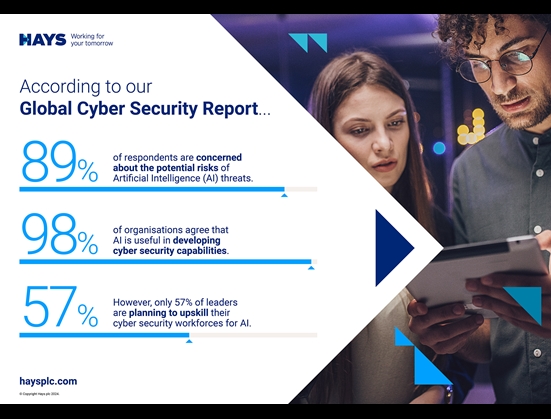Hays’ 2024 Global Cyber Security Report reveals that 89% of cyber security leaders have expressed concern about the potential risks posed by AI threats. Despite this fear, an overwhelming 98% of leaders believe AI will be useful for organisations in developing their cyber security team’s capabilities. As organisations increasingly adopt AI-driven solutions, understanding and mitigating these risks remains a top priority with cyberattacks set to cost the world an estimated $9.5 trillion this year.
Within the wider world of work, AI is beginning to help organisations boost the efficiency of employees by eliminating administrative tasks and speeding up work process. In the world of cyber security, its adoption is poised to revolutionise security practices, from threat detection to incident response.
When asked who stands to gain the most from the AI evolution, 20% of respondents pointed to cyber adversaries leveraging the technology for malicious purposes, 14% identified organisations as the primary beneficiaries, and 63% believe that both organisations and adversaries will benefit equally.

Automation and impact on workers
Contrary to popular fears, the report reveals that nearly half (44%) of those surveyed do not anticipate automation leading to job losses, with only 36% predicting such an outcome by 2026. In fact, 42% reported they are seeking to increase headcount over the next year. This optimism reflects a growing understanding of AI’s potential to augment human efforts rather than replace them.
With 44% of cyber security leaders looking to increase headcount, the remaining 56% merely recognise the need for strategic workforce planning as AI becomes more integrated into security operations. Despite this understanding, the report further revealed that budgetary concerns rank highly, as 87% of business leaders have concerns about their cyber budgets, highlighting the challenge of attracting talent.
Training and Upskilling
Despite the high level of concern over the potential risk that the technology presents, the report reveals that only just over half (57%) of leaders plan to train their cyber security workforce on AI tools within the next year, and a further 25% of leaders do not plan to upskill at all. Balancing technological adoption with workforce readiness remains a challenge, as employees unable to harness the power of new tools could compromise their ability to combat cyber security threats.
The report notes that 73% of organisations invest 5% or less of their cyber security budget into developing talent. Meanwhile, almost twice as many respondents (42%) believed that any further investment should be dedicated to increasing cyber headcount than into training resources. Although organisations would rather hire new cyber talent instead of upskilling their existing employees, the skill-short market does not have enough talent to fill up the headcount, leading to vulnerabilities that can be exploited by hackers.
James Milligan, Global Head of Technology at Hays comments:
“With the prevalence of cyberattacks growing exponentially, the report highlights the pivotal role of AI in shaping the future of cyber security. Organisations must strike a balance between embracing AI’s potential and ensuring their workforce is adequately prepared to deal with the emerging threat landscape.
“Additionally, organisations need to not only embrace emerging technologies and ensure team are educated on benefits and pitfalls, but also to invest in them. It’s important to adapt quickly to a world in which AI solutions are becoming increasingly sophisticated, and at a rate we haven’t previously witnessed while the talent pool for AI skills is limited.
“The research demonstrates that respondents strongly believe that AI can support their team’s cyber capabilities. These tools must be incorporated into the security workforce’s training and development.”